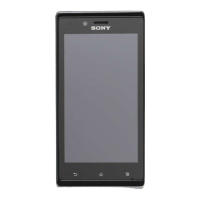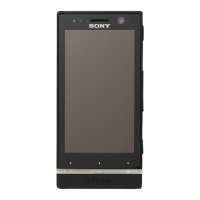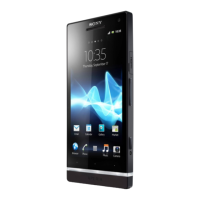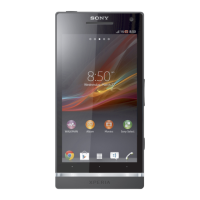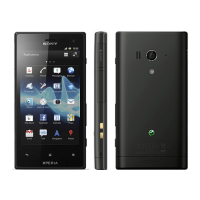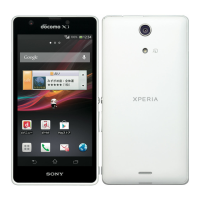Do you have a question about the Sony ST18i and is the answer not in the manual?
Steps to remove and attach the battery cover.
Instructions for powering the phone on, including unlocking the screen.
Procedure to safely shut down the phone.
Synchronizing phone with corporate Exchange ActiveSync accounts.
Diagram and labels for the phone's physical parts and controls.
Explanation of the Home key's function for returning to the main screen.
Detailed steps and notes on charging the phone's battery.
How to select or deselect checkboxes and list options.
Instructions for navigating content by scrolling on the screen.
Procedure for adding widgets to the Home screen.
Creating shortcuts for applications on the Home screen.
Setting a new wallpaper for the Home screen.
Steps to launch an application from the Home or Application screen.
Steps to close a running application.
How to view and manage notifications and active tasks.
Accessing the panel that displays notifications.
Steps to reach the main phone settings menu.
Description of the 12-key phonepad input method.
Manual procedure for setting the date.
Changing the screen brightness level.
Steps to change the phone's display language.
Activating Airplane mode to disable wireless transmissions.
Procedure for erasing all data on the memory card.
Steps to disable all mobile data connections.
Enabling data roaming to use services outside the home network.
Choosing the network mode (e.g., 2G, 3G) for data.
How to make emergency calls, with or without a SIM card.
Managing incoming and outgoing calls.
Redialing numbers directly from the call log.
Steps to initiate a conference call with multiple participants.
Setting up call barring to restrict incoming or outgoing calls.
Viewing the list of accepted numbers for fixed dialling.
Using a PC to transfer contacts from old phones.
Using online accounts to sync and transfer contacts.
Steps to create and save a new contact.
Merging duplicate contact entries into a single record.
Finding contacts by entering their name.
Saving all contacts to the memory card.
Detailed guide to SMS and MMS functionality.
Steps to configure email accounts on the phone.
Composing and sending a new email message.
Reading incoming email messages.
Searching for specific emails within the inbox.
Adding additional email accounts to the phone.
Navigating and interacting with the Timescape™ interface.
Steps to open Timescape™ settings.
Adding new events and reminders to the calendar.
Creating and configuring a new alarm.
Modifying settings for an existing alarm.
Using the snooze function for alarms.
Syncing corporate data directly from the phone.
Configuring a SyncML™ account for data synchronization.
Activating the WLAN feature on the phone.
Steps to find and connect to available WLAN networks.
Interacting with links and pages within the browser.
Saving a web page for quick access later.
Clearing the browser's cache data.
Transferring music, photos, and videos to the memory card.
Identifying music tracks by recording samples.
Steps to identify songs played on the FM radio using TrackID™.
Methods for changing radio channels.
Taking photos using the phone's main camera.
Activating the face detection feature.
Controlling the camera's focus for sharpness.
Recording videos by tapping the screen.
Launching the 3D camera mode.
Improving photo and video viewing quality with BRAVIA® ENGINE.
Opening a specific photo or video album.
Zooming in or out on photos.
Activating GPS for photo geotagging.
Playing recorded videos.
Activating Bluetooth™ and making the phone discoverable.
Steps to pair the phone with a new Bluetooth™ device.
Steps to send files to other Bluetooth™ devices.
Steps to receive files from other Bluetooth™ devices.
Understanding MTP and MSC connection modes.
Steps to transfer content using the Media Go™ application.
How the phone's GPS receiver works.
List of data types that can be backed up using the application.
Protecting your subscription with SIM card lock and PIN.
Setting up a screen unlock pattern.
Setting up an alphanumeric password for screen lock.
Performing software updates over a wireless connection.
Updating phone software using a Mac computer.
Meaning of various icons in the status bar.
Meaning of icons indicating notifications.
Initial steps to resolve phone malfunctions.
Restoring the phone to original settings.
Resolving SIM card lock issues.
Steps to remove and attach the battery cover.
Instructions for powering the phone on, including unlocking the screen.
Procedure to safely shut down the phone.
Synchronizing phone with corporate Exchange ActiveSync accounts.
Diagram and labels for the phone's physical parts and controls.
Explanation of the Home key's function for returning to the main screen.
Detailed steps and notes on charging the phone's battery.
How to select or deselect checkboxes and list options.
Instructions for navigating content by scrolling on the screen.
Procedure for adding widgets to the Home screen.
Creating shortcuts for applications on the Home screen.
Setting a new wallpaper for the Home screen.
Steps to launch an application from the Home or Application screen.
Steps to close a running application.
How to view and manage notifications and active tasks.
Accessing the panel that displays notifications.
Steps to reach the main phone settings menu.
Description of the 12-key phonepad input method.
Manual procedure for setting the date.
Changing the screen brightness level.
Steps to change the phone's display language.
Activating Airplane mode to disable wireless transmissions.
Procedure for erasing all data on the memory card.
Steps to disable all mobile data connections.
Enabling data roaming to use services outside the home network.
Choosing the network mode (e.g., 2G, 3G) for data.
How to make emergency calls, with or without a SIM card.
Managing incoming and outgoing calls.
Redialing numbers directly from the call log.
Steps to initiate a conference call with multiple participants.
Setting up call barring to restrict incoming or outgoing calls.
Viewing the list of accepted numbers for fixed dialling.
Using a PC to transfer contacts from old phones.
Using online accounts to sync and transfer contacts.
Steps to create and save a new contact.
Merging duplicate contact entries into a single record.
Finding contacts by entering their name.
Saving all contacts to the memory card.
Detailed guide to SMS and MMS functionality.
Steps to configure email accounts on the phone.
Composing and sending a new email message.
Reading incoming email messages.
Searching for specific emails within the inbox.
Adding additional email accounts to the phone.
Navigating and interacting with the Timescape™ interface.
Steps to open Timescape™ settings.
Adding new events and reminders to the calendar.
Creating and configuring a new alarm.
Modifying settings for an existing alarm.
Using the snooze function for alarms.
Syncing corporate data directly from the phone.
Configuring a SyncML™ account for data synchronization.
Activating the WLAN feature on the phone.
Steps to find and connect to available WLAN networks.
Interacting with links and pages within the browser.
Saving a web page for quick access later.
Clearing the browser's cache data.
Transferring music, photos, and videos to the memory card.
Identifying music tracks by recording samples.
Steps to identify songs played on the FM radio using TrackID™.
Methods for changing radio channels.
Taking photos using the phone's main camera.
Activating the face detection feature.
Controlling the camera's focus for sharpness.
Recording videos by tapping the screen.
Launching the 3D camera mode.
Improving photo and video viewing quality with BRAVIA® ENGINE.
Opening a specific photo or video album.
Zooming in or out on photos.
Activating GPS for photo geotagging.
Playing recorded videos.
Activating Bluetooth™ and making the phone discoverable.
Steps to pair the phone with a new Bluetooth™ device.
Steps to send files to other Bluetooth™ devices.
Steps to receive files from other Bluetooth™ devices.
Understanding MTP and MSC connection modes.
Steps to transfer content using the Media Go™ application.
How the phone's GPS receiver works.
List of data types that can be backed up using the application.
Protecting your subscription with SIM card lock and PIN.
Setting up a screen unlock pattern.
Setting up an alphanumeric password for screen lock.
Performing software updates over a wireless connection.
Updating phone software using a Mac computer.
Meaning of various icons in the status bar.
Meaning of icons indicating notifications.
Initial steps to resolve phone malfunctions.
Restoring the phone to original settings.
Resolving SIM card lock issues.
| Model | ST18i |
|---|---|
| Announced | 2011, June |
| Dimensions | 111 x 53 x 9.4 mm (4.37 x 2.09 x 0.37 in) |
| Weight | 100 g (3.53 oz) |
| SIM | Mini-SIM |
| Type | LED-backlit LCD, capacitive touchscreen, 16M colors |
| Resolution | 480 x 854 pixels, 16:9 ratio (~297 ppi density) |
| Protection | Scratch-resistant glass |
| OS | Android 2.3 (Gingerbread), upgradable to 4.0 (Ice Cream Sandwich) |
| Chipset | Qualcomm MSM8255 Snapdragon S2 |
| CPU | 1.0 GHz Scorpion |
| GPU | Adreno 205 |
| Internal | 1 GB (300 MB user available), 512 MB RAM |
| Video | 720p@30fps |
| Selfie camera | VGA |
| Loudspeaker | Yes |
| 3.5mm jack | Yes |
| WLAN | Wi-Fi 802.11 b/g/n, DLNA, hotspot |
| GPS | Yes, with A-GPS |
| Radio | Stereo FM radio, RDS |
| USB | microUSB 2.0 |
| Sensors | Accelerometer, proximity, compass |
| Stand-by | Up to 430 h (2G) / Up to 440 h (3G) |
| Status | Available |
| Card slot | microSD |
| Features | Geo-tagging, face detection |
| Bluetooth | 2.1, A2DP |
| Talk time | Up to 7 h (3G) |
| Colors | Black, White, Pink |
| Also known as | Sony Ericsson Xperia Ray, Sony Ericsson Ray |
| Main Camera | 8 MP, AF |

